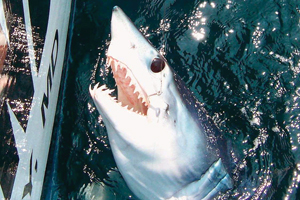Sharks of Maryland: Coexisting with the kings of the ocean

Shark teeth; by Dennis Garcia
Sharks are an important component of Maryland’s marine and estuarine ecosystems, and some are highly sought-after as gamefish. There are four main areas where anglers actively pursue sharks in Maryland: the Atlantic coast surf, nearshore Atlantic waters, offshore Atlantic waters and the Coastal Bays. This article provides a primer on how to responsibly fish for sharks and strategies for staying safe when sharing the water with them.

Mako; by Mark Sampson
Finding fish to bite
Sharks are found year-round in the Atlantic off the Maryland coast. Atlantic sharp-nose, blacktip, dusky, sandbar, spinner, scalloped hammerhead, smooth hammerhead, tiger, sand tiger and smooth dogfish sharks may be found nearshore from May/June through September/October.
Many of those species are caught surf fishing too. Spiny dogfish are available to surf, nearshore and offshore anglers from November to May. Offshore anglers mostly catch blue, short-fin mako and thresher sharks in May and June, although they can be caught into October and November. Sandbar sharks and smooth dogfish are available in Chincoteague Bay from May to October.
Although most shark fishing takes place on the ocean, sharks have historically ascended far into the Chesapeake Bay and still occur there.
Back in 1876, hammerheads were documented at the mouth of the Miles River. Hammerheads have not been reported that far up since, but sandbar and bull sharks regularly visit Maryland’s portion of the bay. They typically arrive in late May and can stay well into October.
Bull sharks have been reported as far north as Aberdeen Proving Grounds, but that is pretty uncommon and usually occurs only in drought years. Most reports are from the mouths of the Choptank, Patuxent and Potomac rivers. Sandbar sharks are also known to use the lower Chesapeake as a nursery and can swim up to Tangier Sound.

Scalloped hammerhead; NOAA
A strategy for survival
Most people catch and release sharks. In federal waters, anglers are required to release sharks in a manner that maximizes survivability. Strategies include keeping the shark in the water at all times, having a release plan and the right tools such as a dehooker or line cutters, cutting the line as close to the hook as possible, no gaffing and using corrodible, non-offset circle hooks. Additionally, surf anglers are asked not to drag sharks onto the sand, not to sit on them and not to hold open jaws.
At the suggestion of shark fishing expert Capt. Mark Sampson, the Maryland Department of Natural Resources teamed up with him in 2012 to conduct a recreational hook study. Although the benefits of circle hooks were well known, there was no specific research confirming that for sharks. The following species were included in the study: Atlantic sharpnose, blue, blacktip, dusky, sandbar, scalloped hammerhead, shortfin mako, smooth hammerhead, spinner and tiger sharks.
The three-year study confirmed that circle hooks outperform J hooks. Circle hooks were also shown to deep hook fewer sharks than J hooks, which serves as a conservation measure to positively contribute to maximum survivability.
The shortfin mako and Atlantic sharp-nose are the most commonly kept sharks in Maryland. Anglers that keep a shark must ensure that it is legal to keep. Sharks can be difficult to distinguish, especially since they are not frequently encountered by most anglers.
Many of the sharks commonly caught off Maryland are prohibited species and must be released. Examples of recreationally prohibited species include sandbar, dusky, silky and sand tiger sharks.
Shark Interactions
There has never been a reported shark bite in the Chesapeake Bay and only one in Chincoteague Bay. However, there has been at least one angler mishap off Assateague.
| Before going shark fishing… 1. Get some firsthand practical experience identifying, handling and gearing up from local mentors such as a fishing group, guide or charter captain. 2. Have the appropriate license(s), tackle, tools, measuring tape, identification guide, regulations and a release plan. 3. Check for local regulations. The Town of Ocean City has relevant surf fishing ordinances. 4. Fishing for sharks in federal waters anywhere from three to 200 miles from the coast requires a National Oceanic Atmospheric Administration Highly Migratory Species permit. |
| Reduce your risk
Never swim alone. |
Identification tips
A few additional reminders: Make sure to meet minimum size requirements, if applicable. Complete a Maryland Catch Card if required by Code of Maryland Regulations and then tag it. This is not necessary for spiny dogfish. |
Article by Angel Willey—coastal fisheries program manager.
Appears in Vol. 20, No. 3 of the Maryland Natural Resource magazine, summer 2017.

